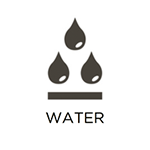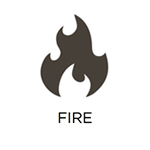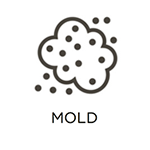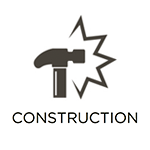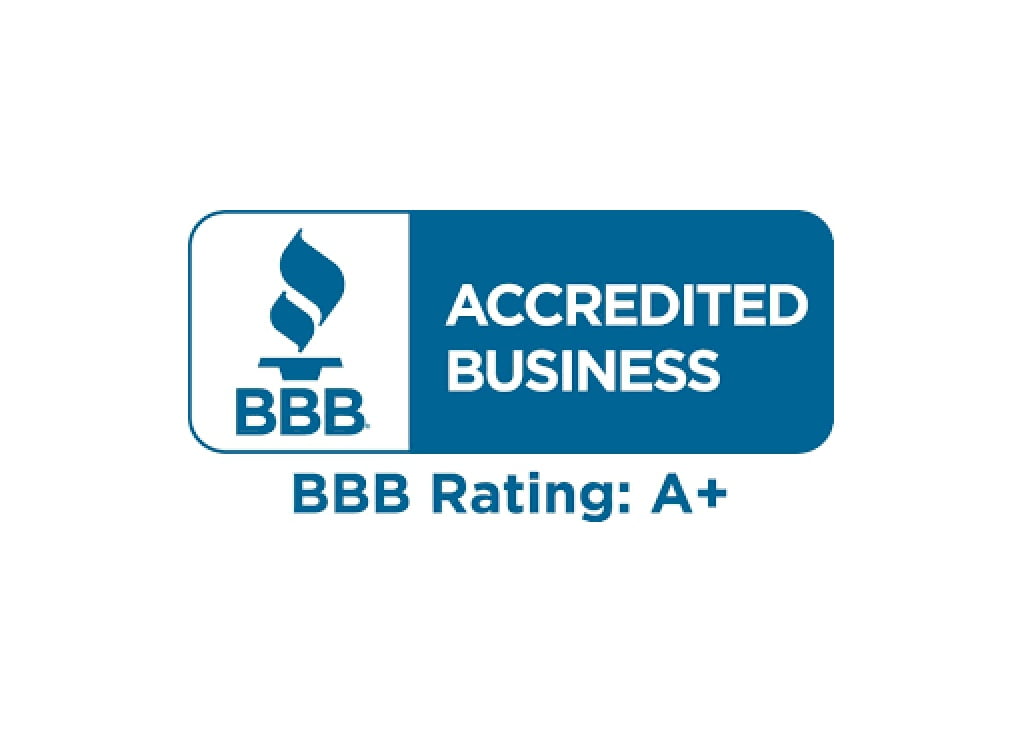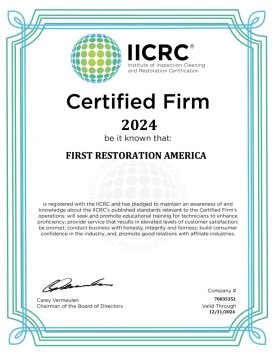First Restoration America
At First Restoration America, we provide expert flood cleanup services for homes and businesses in Charlotte, NC, and nearby areas like Mecklenburg County, South End, Ballantyne, and Uptown. Our IICRC-certified technicians are here to help you recover quickly from water damage, offering fast, reliable restoration. We understand that flood damage needs immediate attention, which is why we’re available 24/7 and can be at your property in 60 minutes or less to begin the cleanup.
Flooding in Charlotte is a common issue, especially with heavy rain, storms, and rising water levels in areas like the Catawba River and Little Sugar Creek. In 2024, Hurricane Helene brought over 12 inches of rainfall to Mecklenburg County, causing widespread flooding and significant property damage. For more details on local flood risks, you can visit the North Carolina Floodplain Mapping Program.
If you’re dealing with flood damage or standing water in your property, First Restoration America is ready to help. Call us now at (980) 888-8456 for a free estimate. We are locally owned experts and have been in this industry for more than 30 years.
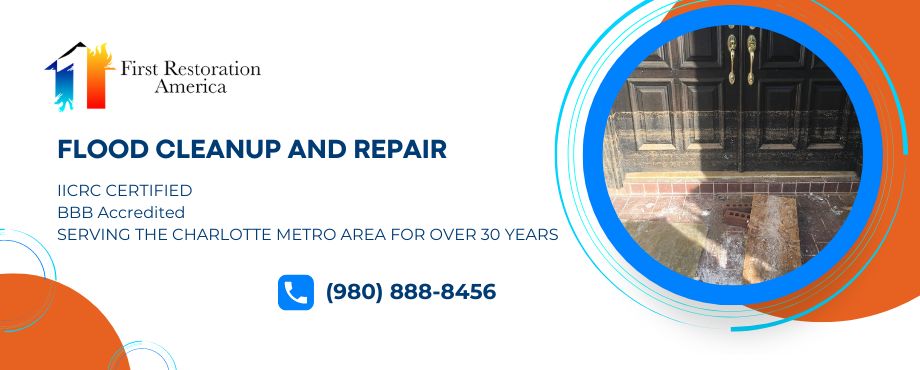
Common Causes of Flood Damage in Charlotte
Flood damage can occur due to a variety of factors, both internal and external. Here are the most common causes:
- Heavy Rainfall and Storm Flooding: Intense rainfall, especially in flood-prone areas, can cause rivers, creeks, and storm drains to overflow, flooding nearby properties.
- Burst Pipes and Plumbing Failures: Internal flooding from burst pipes, clogged drains, or sewage backups is common, particularly in older plumbing systems.
- Sewage Backups & Drain Overflows: Floodwaters can push sewage into homes, requiring biohazard cleanup.
- Crawl Space & Basement Flooding: Poor drainage or sump pump failures lead to standing water issues.
- Hurricanes and Tropical Storms: Strong winds and heavy rains from hurricanes and tropical storms can overwhelm drainage systems, leading to significant flooding.
- Overflowing Rivers and Lakes: Flooding often happens when bodies of water, like rivers and lakes, overflow due to prolonged rain or rapid snowmelt.
No matter the cause, First Restoration America has the expertise and equipment to handle flood cleanup in Charlotte, NC
Our Professional Flood Cleanup Process
As a BBB-accredited company and IICRC-certified provider, we take pride in delivering high-quality service. Our focus is on making the restoration process smooth and efficient, so your property is restored to its original condition with the highest level of care and professionalism. Here’s how we handle the process:
- Emergency Water Removal: We start by using powerful pumps and vacuums to quickly remove standing water, stopping further damage before it gets worse.
- Structural Drying & Dehumidification: Next, we use industrial-grade air movers and dehumidifiers to dry out floors, walls, and structural components, preventing mold from growing and ensuring your property is dry.
- Sanitization & Mold Prevention: To protect your home, we apply antimicrobial treatments and carry out mold inspections, ensuring the environment is safe and healthy.
- Flood Damage Repair & Restoration: Finally, our team handles all the repairs—drywall, flooring, and anything else damaged by the flood—restoring your property back to its original condition.
Major Flood Zones in Charlotte, NC
In Charlotte, NC, major flood zones are typically identified through FEMA’s Flood Insurance Rate Maps (FIRMs). The areas prone to flooding are categorized into different flood zones. Here are some of the notable flood zones and areas in Charlotte:
- Flood Zone A: Areas that are at high risk for flooding but have no base flood elevation determined. This zone includes parts of East Charlotte and neighborhoods near the Catawba River and Little Sugar Creek.
- Flood Zone AE: Areas where base flood elevations are determined. This zone often includes areas along the larger rivers and creeks, such as the Catawba River, and parts of the South End and North End neighborhoods.
- Flood Zone X: Areas with a moderate to low risk of flooding. While not as high-risk as zones A and AE, this zone includes regions in the outskirts of Charlotte and some suburban areas.
- Flood Zone AH: Areas with shallow flooding, often with ponding of water. This zone can include low-lying areas and places where drainage is poor.
When your Basement Floods, Call First Restoration America
Basement flooding is a common concern for homeowners and can result from various factors. These include sump pump failure, gutter overflow, or structural issues like holes in basement walls that allow outside water to seep in. If your laundry room is in the basement, a burst pipe also increases the risk of flooding. These factors show just how vulnerable basements are to water damage.
If you notice water pooling in your basement, don’t wait—contact First Restoration America immediately. As part of our basement flood cleanup process, we begin by extracting any standing water from your property. Next, we thoroughly clean all affected areas, including hard-to-reach spots behind and under appliances. We use industrial-grade air movers and dehumidifiers to dry out the basement and any materials impacted by the flood.
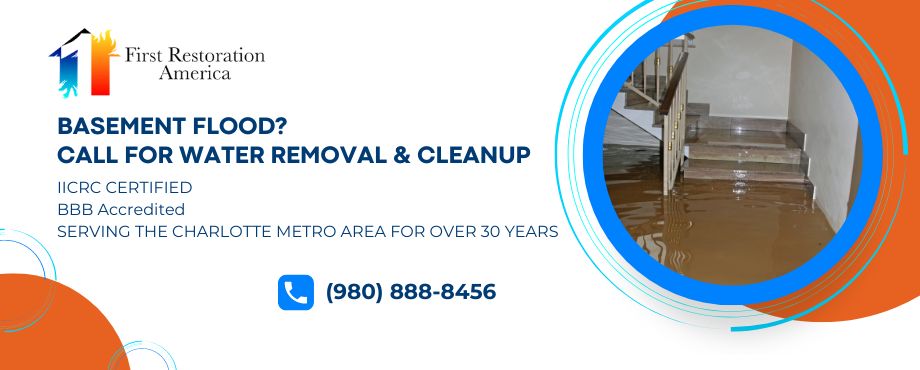
Flood Damage Repair in Charlotte
Leaky roofs or ceilings and standing water can cause significant damage to your flooring, carpets, drywall, or walls. This damage may appear as water stains, discoloration, squeaky sub floors, weakened ceilings, and warping or bubbling paint on walls. Our flood damage repair services involve replacing and rebuilding any affected building materials to address these issues. Neglecting these repairs could result in further deterioration and more extensive damage over time.
What to Do After Flood
If a flood should occur in your home or business, call the First Restoration America immediately to begin the water damage restoration process. After placing the call, perform the following actions before our technicians arrive:
- Mop or blot dry to soak up excess water.
- Wet area rugs and floor coverings should be removed.
- Keep draperies off the floor by putting the bottoms through a coat hanger and putting the hanger on the drapery rod.
- Wipe down wet furniture and prop up the cushions, put aluminum foil under furniture legs.
- Remove photos and paintings and store them somewhere safe.
- Keep all drawers, doors, and closet and cabinet doors open to help the drying process.
What NOT to Do After Flood
- Do not enter a flooded room while the power is on.
- Do not try to remove water with a regular vacuum cleaner.
- Do not remove permanent carpeting without the help of a professional.
- Do not use electrical appliances while standing on a wet floor.
- Do not clean up visible mold growth.
- Do not take wet books of their shelves; instead pack them together tightly to keep the pages from warping until they can be properly treated.
Call us for Flood Cleanup Services in Charlotte, NC
If you have experienced flooding in your home or business in Charlotte, NC, do not hesitate to contact First Restoration America at (980) 888-8456 for flood cleanup. Our phone lines are open 24 hours a day, 7 days a week for quick response to emergencies.
Commonly Asked Questions About Flood Restoration
Q. Who is responsible for flood damage? Landlord or Tenant?
Landlords are usually responsible for maintaining the property and fixing issues that cause flooding. However, if a tenant’s actions lead to flooding, they may be held responsible. For example, tenants are liable for water damage resulting from negligence, such as leaving faucets open or causing water pipes to burst. In these cases, the tenant must cover the repair costs.
Q. How to remove musty smell from basement after flooding?
A musty smell after a flood can indicate the presence of mold and mildew. To remove this odor, use dehumidifiers, cat litter, or baking soda to absorb the moisture and any residual smells.
Q. How to dry flooded carpet?
To dry a flooded carpet, start by using a wet/dry vacuum to remove water. Then, lift the carpet to let air circulate underneath and remove the wet padding. Use fans and dehumidifiers to dry the carpet faster. Open windows for ventilation if possible.
Q. How long does it take for flood water to clear?
Flash floods usually go away in hours, but natural floods can stick around for days or even weeks. If a flood is caused by a clogged or damaged drain, it might keep coming back until the drain is fixed.
Helpful Resources
Does Flood Insurance Cover Burst Pipes?
Flood insurance does not cover burst pipes unless the burst is a direct result of a flood. Flood insurance is designed to cover damage caused by rising water levels from natural events like heavy rain, storm surges, or overflowing rivers. Burst pipes are usually covered under a separate policy, such as homeowners insurance.
How are Floods Measured?
Floods are measured in different ways to keep track of water levels and flow rates. River gauges are set up along rivers and streams to give real-time updates on how high the water is. Rain gauges help measure how much rain has fallen in a specific area. Remote sensing tools, like satellites and radar systems, keep an eye on flood-prone regions by monitoring rainfall intensity and soil moisture levels. By pulling together information from these sources, authorities can get a clear picture of floods, issue warnings, and take steps to keep people and property safe.
Recent Reviews
Dan Davoli
"I’m thrilled with the work done by First Restoration. The crew was punctual, professional, clean, and the project started and ended when they said it would! The price for my remodel was very competitive, and there were no “surprises” along the way. Within 2 days of the project being completed, I received a call from the owner of the company asking if I needed anything else, and if I was satisfied. I appreciated the personal touch and desire to ensure I was satisfied with their work product. 5 stars!"
Kevin Norton
"First restoration was great. I had a leak from an upstairs washer. Keith answered my call right away. Employees arrived a few hours after my call and set up the fans and dehumidifier. First restoration was great and would strongly recommend them in the future."
Judy Hudson
“Fortified with a sense of humor, First Restoration was able to come into my home during some really tough times. They not only helped me when I needed them most following Hurricane Matthew but were also reliable and honest about their work- completed in timely manner too! Plus they have this great attitude that makes you want them on every project from hereon out... I would highly recommend using these guys if anyone wants an excellent restoration service done right”
See All Reviews


